Shipping fleet statistics: 2022
Published 29 March 2023
About this release
This statistical release presents summary statistics for UK and world shipping fleets. It provides different measures of UK shipping interests, set in the global context, including analyses by country of registration (flag) and trading vessel type. Every merchant ship must be registered in a country (the ‘flag state’) and ship registration can, in part, be considered as an indicator of the overall health of a country’s maritime sector. All figures are based on vessels of 100 gross tonnes or over. Other variables and a longer time series are available in accompanying data tables.
Changes to the shipping fleet release
This release presents figures from 2 different data sources, the Maritime and Coastguard Agency (MCA) official UK Ship Register data and commercially procured world shipping fleet data to put the UK fleet in the context of the global fleet.
DfT procure world shipping fleet data via open competition. In April 2022, the contract was awarded to Sea/ by Maritech (www.sea.live) for the first time. Therefore, the world fleet information as at December 2022 used in this release is based on data supplied by Sea/ while previous years are based on data provided by IHS.
DfT conducted sensitivity checks between the 2 data sources and found that deadweight and gross tonnage were comparable. Therefore, this release makes year on year comparisons between the 2 data sources, however, these should be used with caution. UK ownership and management (section 3 of the 2021 release) has not been updated in this release, it is not yet available as more time is needed to ensure consistency between the datasets. This information will be updated alongside another maritime statistics publication as soon as is practicable, at the latest with the 2023 release. More details about the changes to our data can be found in the notes and definitions.
The department is currently reviewing the data tables available on shipping fleet statistics. We welcome any comments on the proposed changes which are detailed in the user feedback survey. Subject to feedback, these changes will be implemented for the next publication in March 2024.
Headline figures
Gross tonnage on the UK Ship Register (UKSR) rose 1% to 10.3 million gross tonnes at end December 2022.
Official data from the MCA, for all merchant vessels over 100 gross tonnes, shows that gross tonnage on the UKSR increased but remains 36% lower than the 2017 peak.
Based on world fleet data (supplied by Sea/) for trading vessels only, at the end of 2022, the UK registered trading fleet:
-
accounted for 0.5% of the world fleet on a deadweight tonnage basis (a measure of cargo carrying capacity), and 0.6% when based on gross tonnage (a measure of vessel size), remaining stable since 2020, which is based on ‘IHS’ data
-
was the 23rd largest trading fleet in the world, on a deadweight tonnage basis, broadly similar to 2021 (24th in 2021 based on ‘IHS’ data)
-
accounted for 23% of deadweight tonnage of the Red Ensign Group trading fleet, which as a whole would be the world’s 10th largest trading fleet. This share has remained stable since 2014.
Things you need to know
Data source
This release presents figures from 2 different data sources:
-
section 1 presents figures for the UK Ship Register, provided by MCA, which show trends in the UK registered fleet using official data
-
sections 2 uses data from a commercial source Sea/ (and predecessors for previous years) to provide context, giving the UK position in the global fleet (section 2).
Coverage differs between the 2 sources, for example, the MCA data includes some vessels not captured in the commercial source, many of which are inland waterway vessels (for example barges, passenger vessels operating on rivers and inland tankers). Both the MCA and Sea/ data do not include non-merchant vessels such as fishing boats and some yachts.
In sections 2 of this publication, data from the commercial source are presented for trading vessels only, and on a deadweight tonnage basis (to be consistent with previous publications). This means vessel numbers and tonnage are not directly comparable with the official figures given in section 1, which will for example include some ‘non-trading’ merchant vessels.
Users are advised to use MCA figures for a definitive picture of the state of the UK Register. The commercial data provides access to a wider range of contextual information (such as the world fleet or Red Ensign group, ownership or vessel details) or a longer historic series. An overview of the main differences between the 2 sources are outlined in the notes and definitions.
Coverage
Time period
Both sources relate to the fleet as at 31 December of each year.
Vessel size
Both sources relate to vessels of 100 gross tonnes (GT) or over.
Vessel type
UKSR figures cover merchant vessels, including bareboat charters (parts I and IV of the register). Figures from the Sea/ data presented in this release relate to trading vessels - those which carry cargo or passengers for commercial purposes. However, the accompanying data tables also cover non-trading vessels (for example, fishing vessels). Around half of UK registered vessels classified as non-trading vessels in the Sea/ data are included in the UKSR statistics.
Key definitions
Measures of ship size (tonnage) There are 2 alternative ways that the size of ships is measured within these statistics.
Gross tonnage (GT) represents the size of the vessel and is not a measure of weight. It is calculated using a formula based on the volume of enclosed spaces of the vessel. It is used to assess the cost of vessel registration, and is the headline tonnage measure for the UKSR
Deadweight tonnage (DWT) measures the cargo carrying capacity of a vessel, excluding the weight of the ship itself. In general, DWT has been used as the main measure where statistics are based on world fleet data (as in previous years), as overall trends are broadly similar for both measures. The accompanying data tables contain figures for both DWT and GT.
Measures of shipping interests
A country’s shipping interests may be measured in different ways. UKSR statistics relate to vessels which are registered in the UK. These vessels may be owned or managed by non-UK companies; the commercial data provides other measures of UK shipping including ownership and management. This is not yet available for 2022 update as more time is needed to ensure consistency between the datasets. This information will be updated alongside another maritime statistics publication as soon as is practicable, at the latest with the 2023 release.
Section 1: The UK Ship Register
The figures in this section are based on UK Ship Register data from MCA. In the year to end December 2022:
-
the UK registered merchant fleet rose by 1% in gross tonnage
-
overall vessel numbers continued to decrease, falling by 3% compared to 2021 despite the slight increase in gross tonnage
-
gross tonnage was 36% lower than the 2017 high. After 3 years of growth up to 2017, gross tonnage declined sharply in 2019 and has since levelled off
Decline in tonnage on the UK shipping register between 2018 and 2020 is likely to be related to uncertainty over the UK’s exit from the EU. The decline between 2018 and 2019 largely reflects one company’s decision to change the flag of its fleet.
Consistent official figures exist back to 2003, though commercial data shows (see section 2) that over the longer term, the UK registered fleet was at historically low levels during the 1990s, before increasing in the decade to 2009. This may reflect the impact of the UK tonnage tax scheme introduced in 2000 in promoting the UK Ship Register. Tonnage Tax companies are required to elect into the regime for a 10-year period and may extend that election on a rolling annual basis.
Between 2009 and 2014, the UK registered fleet declined, with a couple of larger companies moving their fleets away from the UK flag for commercial reasons during this period. The Maritime Growth Study (MGS), published in 2015, was launched in response to these trends, with the aim of growing the sector; the UK Ship Register Advisory Panel report also covered possible actions to increase the size of the UK flag.
Chart 1: Gross Tonnage, in millions, on the UK Ship Register at end year, 2003 to 2022 FLE0100
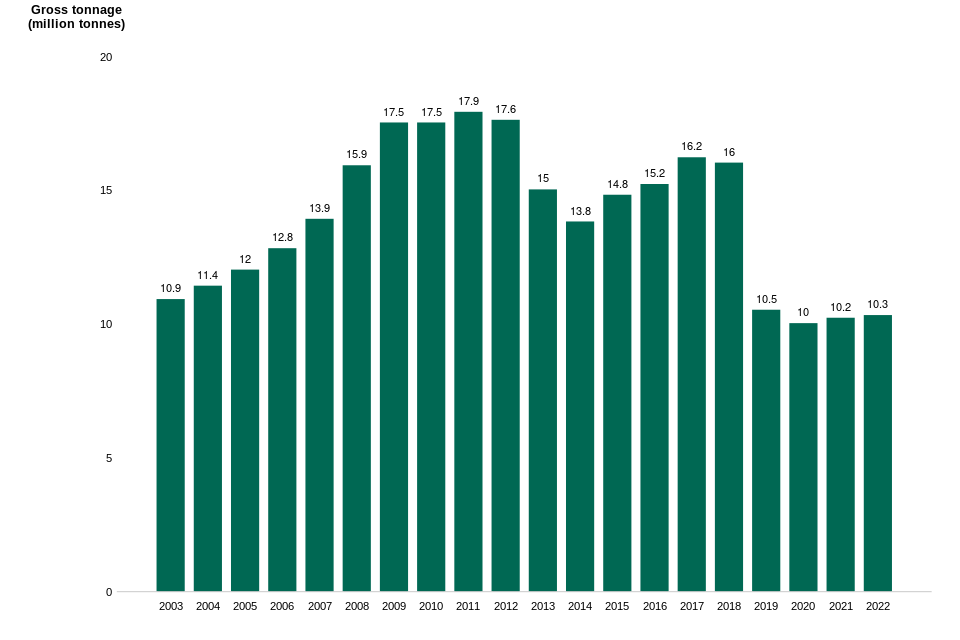
Further information
The table FLE0100 presents end year statistics for the UK Ship Register.
Further information about the UKSR and ship registration is published by the MCA.
Section 2: Trading fleets: World and Red Ensign Group
The 2022 figures in this section are based on world fleet data supplied by Sea/. Any data prior to 2022 is based on IHS data, and year on year comparison will be comparing data from Sea/ and IHS.
These figures cover trading vessels over 100 gross tonnes, and are not directly comparable with the UKSR statistics presented in section 1 (a brief comparison of the 2 sources is given in the notes and definitions.
Based on data from Sea/, the UK share of the world trading fleet was 0.5% by deadweight tonnage and 0.6% by gross tonnage at the end of 2022. The UK registered trading fleet was the 23rd largest trading fleet in the world by deadweight tonnage.
At the end of 2022, there were around 61,000 vessels in the world trading fleet, with a total deadweight tonnage of 2,168 million. By deadweight tonnage, the world fleet has almost doubled in size since 2007 and growth remains linear, increasing by 3% in the latest year (please note that last year’s figure is based on ‘IHS’ data).
Chart 2: World trading vessels over 100 gross tonnes, million deadweight tonnes FLE0502
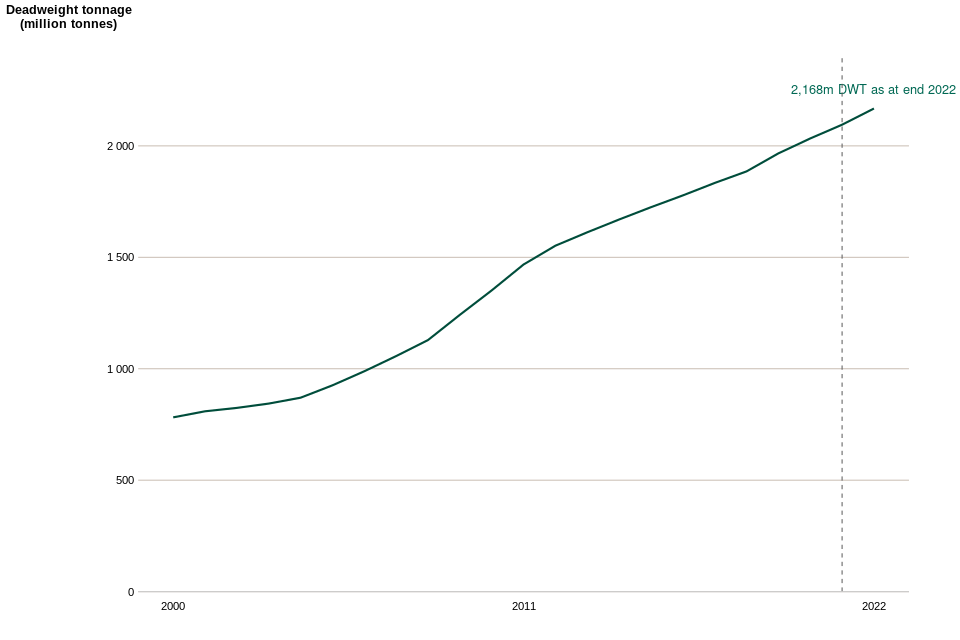
Note - the dotted line in 2021 refers to a change in series due to a change in data provider.
The UK registered share of the world fleet has remained broadly stable on the previous year.
Chart 3: UK registered share (%) of world fleet deadweight tonnage - trading vessels over 100 gross tonnes FLE0502
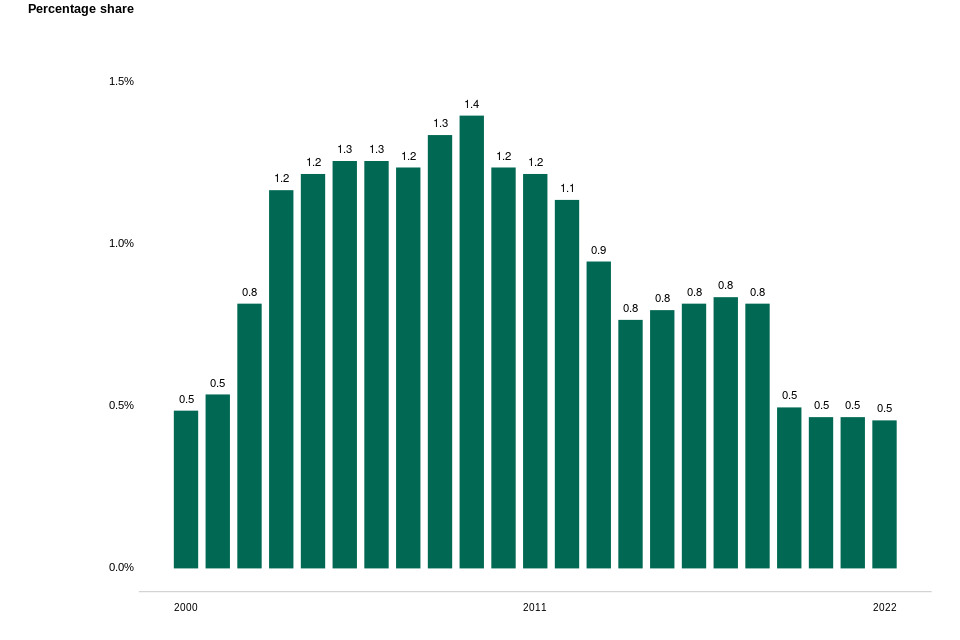
The UK registered share of the world trading fleet has remained stable in 2022 compared to 2021, following a large decrease in 2019. On a deadweight tonnage basis, the UK’s share of the world trading fleet has remained at 0.5%, a similar proportion for the last 4 years. On a gross tonnage basis, the UK’s share has stayed at 0.6% in 2022.
The UK registered trading fleet is the 23rd largest in the world by deadweight tonnage, broadly similar to 2021 (24th in 2021 based on IHS data). The largest trading fleets, such as Panama, are open registers, available to all ships regardless of the place of business of the owner. The UK register is a traditional, or national registry, which requires ships to be owned, at least in part, by national interests (registration information) for the UK is published by MCA). The large open registers also account for a large proportion of the overall growth of the world fleet in recent years, most notably the Marshall Islands.
Red Ensign Group countries
The Crown Dependencies are the Isle of Man, Jersey, and Guernsey. Of these, the Isle of Man accounts for over 99.9% of the combined deadweight tonnage.
The Overseas Territories are Anguilla, Bermuda, British Virgin Islands, Cayman Islands, Falkland Islands, Gibraltar, St Helena, the Turks and Caicos Islands and Montserrat.
The UK registered trading fleet was the 23rd largest in the world by DWT in 2022.
Chart 4: The largest ship registers by deadweight tonnage (vessels over 100 gross tonnes, million deadweight tonnage), end 2022.
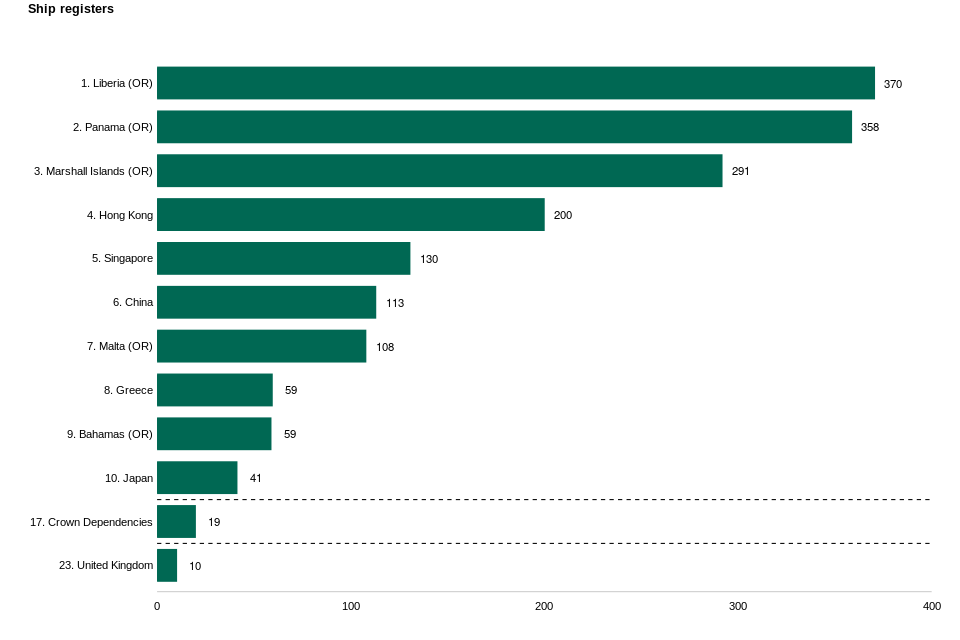
Note - OR shows fleets that are open registers - registers available to ships regardless of the nationality of the business owner.
If taken as a group, the Red Ensign Group would have the 10th largest registered trading fleet in the world at the end of 2022, the same rank as in 2021. The total registered deadweight tonnage has decreased for the fourth consecutive year, reducing by 4% from 2021 to 43 million deadweight tonnage.
The Red Ensign Group is the collective title for the shipping registers of the UK, the Crown Dependencies, and the Overseas Territories. Registration with the Red Ensign Group provides vessels with the support of British consular services worldwide, UK defence and security responsibilities also extend to vessels flagged to the Red Ensign Group.
The UK accounts for 23% of the deadweight tonnage of the Red Ensign Group trading fleet, whilst the Crown Dependencies (effectively the Isle of Man) account for 45% and the Overseas Territories account for 32%. From 2003 to 2009, the UK and Isle of Man registered trading fleets were at a broadly similar level. Since 2009, the Isle of Man trading fleet has grown more than 70% up to 2018. However, the Isle of Man register has declined since 2018, with gross tonnage and deadweight tonnage both falling by 4% and 3% respectively, in the latest year.
Statistical tables
Whilst the Crown Dependencies and Overseas Territories have seen reductions in their trading fleets in 2022, the UK’s gross tonnage and deadweight tonnage have both increased with deadweight tonnage rising by 3%. The Red Ensign Group’s deadweight tonnage has been steadily increasing from 2009 to 2018 with a dip between 2013 and 2015. In 2019, it started declining sharply, falling by 28% in 2022 compared to 2018.
The Crown Dependencies ranked as the 17th largest registered trading fleet in the world measured by deadweight tonnage at end 2022, and in combination, the Red Ensign Group would be in 10th place (43 million deadweight tonnage). Outside the UK, Red Ensign Group members, like many non-European open registries, are able to offer very attractive fiscal regimes to potential customers.
The Crown Dependencies (largely Isle of Man) account for nearly half of deadweight tonnage for the Red Ensign Group trading fleet (45%), but their register has declined. As a result, the UK’s deadweight tonnage as a proportion of the total deadweight tonnage of the Red Ensign Group has increased over the last 3 years.
Chart 5: REG registered trading vessels over 100 gross tonnes, million deadweight tonnes FLE0402.
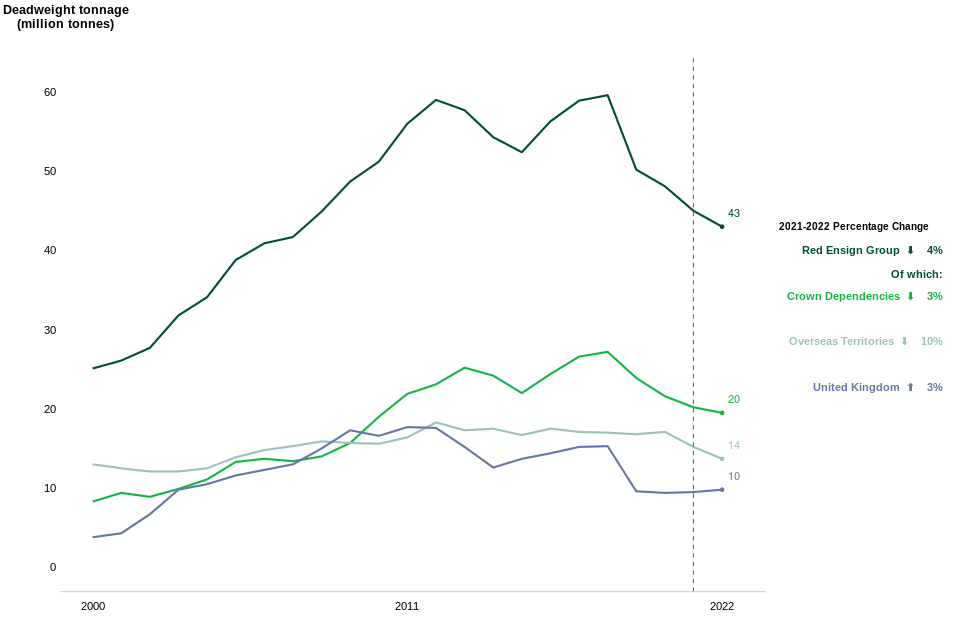
Note - the dotted line in 2021 refers to a change in series due to a change in data provider
Further detail
Detailed statistical tables containing breakdowns and time series of the number, deadweight tonnage and gross tonnage of vessels by type of vessel, size of vessel, fleet definition, and selected international fleets can be found in the maritime and shipping statistics collection.
Further guidance on the methods used to compile these statistics can be found on the notes and definitions.
Related information
The MCA is responsible for ship registration in the UK, and maintains the definitive UK ship register, to which the figures in section 1 of this publication relate.
The 2015 Maritime Growth Study report provides further analysis of the UK and world fleet data and background context.
A range of other sources provide information on the global shipping fleet. For example, the UNCTAD annual Review of Maritime Transport includes a more in-depth analysis of trends in the global fleet (though based on an alternative source of data than is used for this publication).
Instructions for printing and saving
Depending on which browser you use and the type of device you use (such as a mobile or laptop) these instructions may vary.
You will find your print and save options in your browser’s menu. You may also have other options available on your device. Tablets and mobile device instructions will be specific to the make and model of the device.
How to search
Select Ctrl and F on a Windows laptop or Command and F on a Mac
This will open a search box in the top right-hand corner of the page. Type the word you are looking for in the search bar and press enter.
Your browser will highlight the word, usually in yellow, wherever it appears on the page. Press enter to move to the next place it appears.
Contact details
Maritime and shipping statistics
Email maritime.stats@dft.gov.uk
Media enquiries 0300 7777 878
